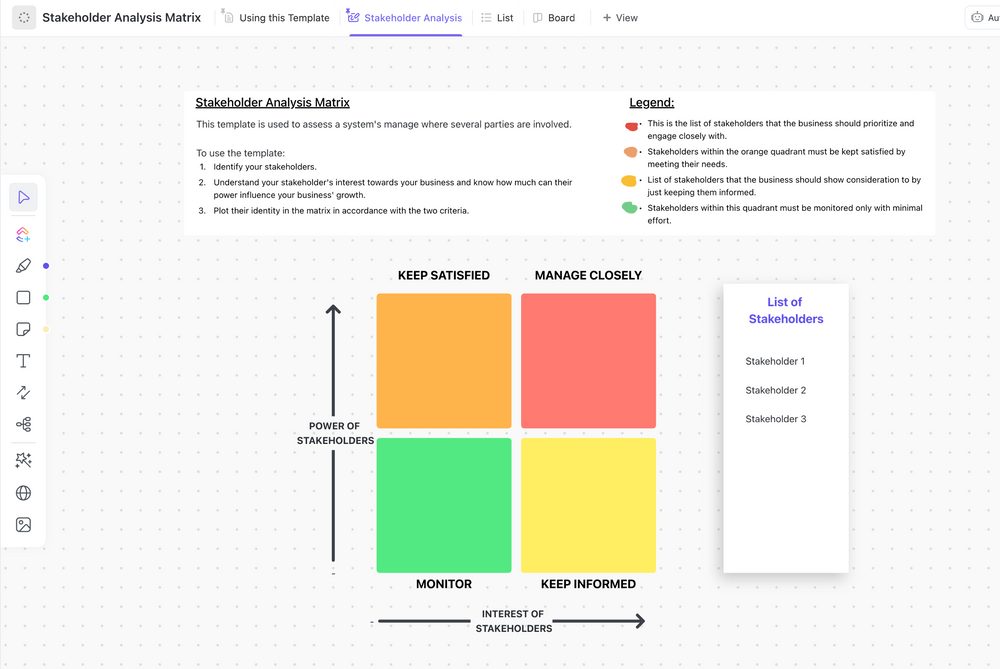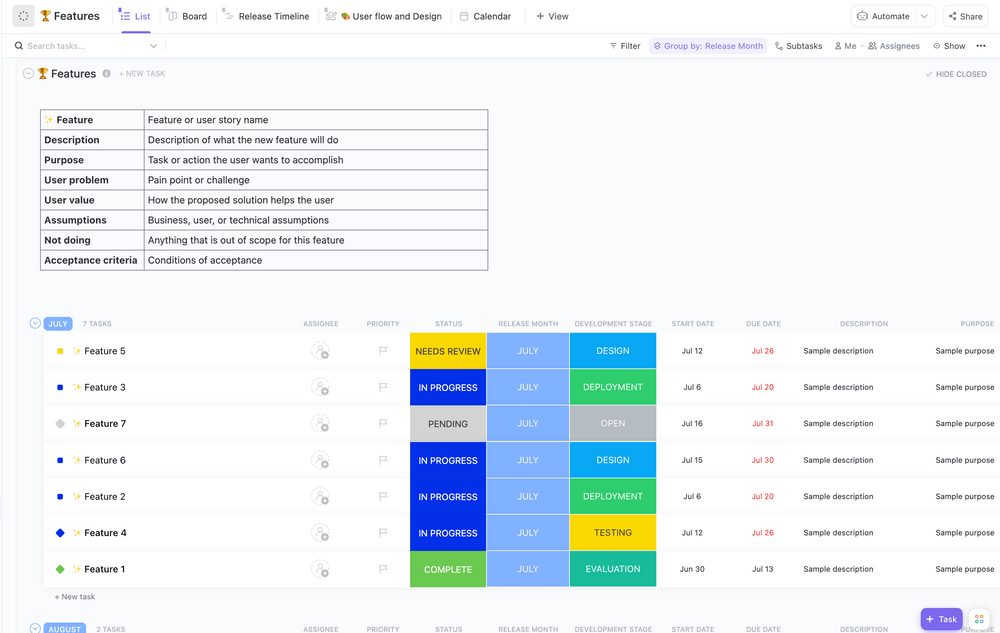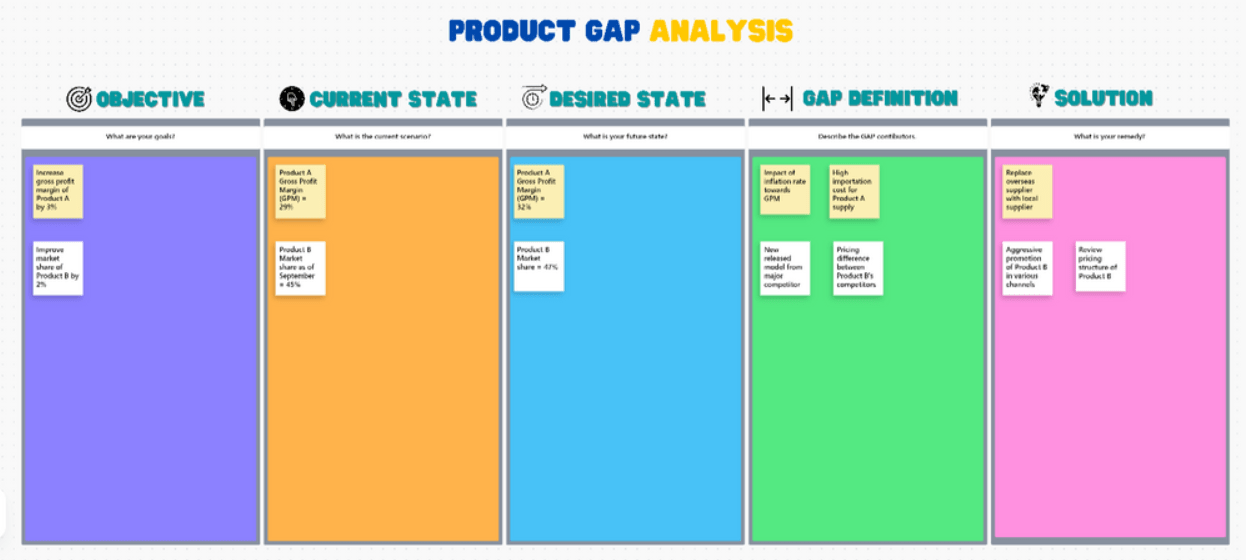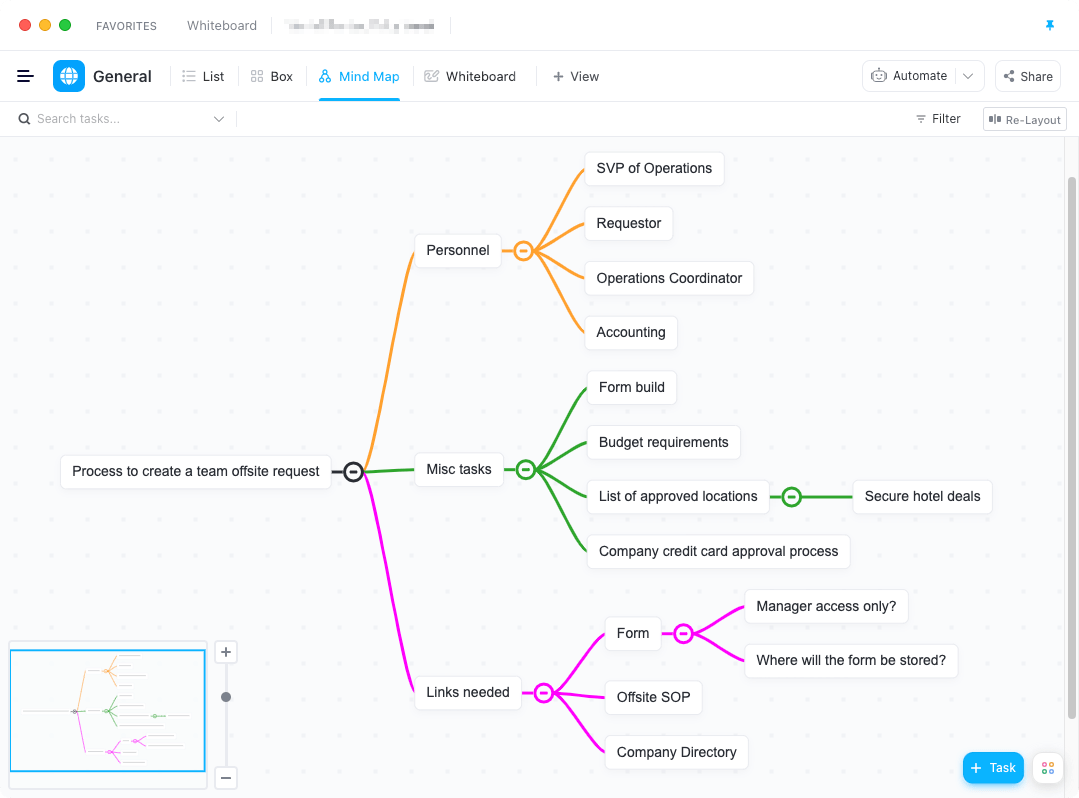تخيل أنك تبني منزلاً دون أدنى فكرة عن حجمه ومخططه النهائي. لن تعرف كم يجب أن تكون أساساتك عميقة، وكم المواد التي يجب أن تطلبها، وكم عدد العمال والأيام التي ستستغرقها للانتهاء من البناء. وبعبارة أخرى، بدون أن تكون على دراية بالمتطلبات، فإن مشروع بناء منزلك محكوم عليه بالفشل حتى قبل أن يبدأ. 🏠
ينطبق الأمر نفسه على تطوير البرمجيات - فأنت بحاجة إلى فهم ما يجب أن يحققه المنتج بشكل صحيح منذ البداية. وبدون ذلك، فإنك تخاطر بأن ينتهي بك الأمر مع برنامج قد يعمل بشكل مثالي، ولكن ليس بالطريقة التي يريدها ويتوقعها المستخدمون النهائيون والعملاء.
وهنا يأتي دور تحليل المتطلبات، مما يساعدك على تحديد وتوثيق وتحليل وتحديد وتحديد المتطلبات احتياجات أصحاب المصلحة وتوقعاتهم من نظام جديد أو مجدد. إنه نشاط حاسم في معرفة نطاق المشروع والحفاظ على التوافق بين أصحاب المصلحة والمطورين، وفي نهاية المطاف، تحسين رضا العملاء وجودة المخرجات.
إذن، ما هو تحليل المتطلبات هذا، ومن يقوم به، وكيف، ومتى؟ سنجيب عن كل هذه الأسئلة وأكثر في هذه المقالة، لذا ترقبوا معنا!
ما هو تحليل المتطلبات؟
في حين أن أي نوع من المشاريع تقريبًا يمكن أن يستفيد من تحليل المتطلبات (المعروف أيضًا باسم استنباط المتطلبات وتحليلها)، إلا أنه يتم إجراؤه بشكل شائع في تطوير البرمجيات الصناعة. إنها جزء من عملية هندسة البرمجيات ذات المتطلبات الأوسع نطاقاً والتي تُستخدم لفهم وتحليل متطلبات أي مشروع تطوير البرمجيات .
والهدف منه هو إزالة أي غموض وسوء فهم من عملية تطوير المنتج التأكد من أن فريقك وأصحاب المصلحة على نفس الصفحة.
تشمل الأنشطة التي تدخل في عملية تحليل المتطلبات النموذجية ما يلي:
- تحديد أصحاب المصلحة الرئيسيين: وتشمل المستخدمين النهائيين والعملاء والعملاء والأطراف المعنية الأخرى
- جمع متطلبات أصحاب المصلحة: جمع المعلومات حول الميزات والقيود والأهداف المرغوبة
- التوثيق : إنشاء سجل منظم لـقصص المستخدمين,حالات الاستخدامومواصفات المنتج الأخرى
- التحليل: تقييم صلاحية واتساق المتطلبات التي تم جمعها وحل أي تعارضات
- تحديد أولويات المتطلبات: يساعد فيتخصيص الموارد ويؤدي إلى تحسينصنع القرار: الخروج بعمليات للتعامل مع المتطلبات المتغيرة طوال دورة حياة التطوير
متى يتم إجراء تحليل المتطلبات؟
يتم إجراء تحليل المتطلبات بشكل عام في المرحلة المبكرة من مشروع التطوير قبل الانتقال إلى مراحل مثل التصميم والتنفيذ والاختبار.
قد ترغب أيضًا في إجراء تحليل مفصل إذا خضع منتجك أو نظامك الحالي لتغييرات كبيرة. إنها طريقة لفهم الميزات الجديدة المطلوبة والحصول على موافقة أصحاب المصلحة على أي تعديلات تريدها.
في إدارة المشاريع الرشيقة على وجه التحديد، فإن تحليل المتطلبات هو عملية عمل مستمرة بدلاً من أن تكون عملية تنجز مرة واحدة وتنسى إلى الأبد. يتم إجراؤه على فترات منتظمة، مما يسمح بما يلي فرق رشيقة لتعديل المتطلبات بما يتماشى مع أحدث ملاحظات العملاء والرؤية
من يقوم بتحليل المتطلبات؟
تحليل المتطلبات هو جهد تعاوني يشارك فيه العديد من أصحاب المصلحة الرئيسيين في عملية تطوير البرمجيات، وغالبًا ما يكون ذلك:
- مديرو المشاريع
- مالكو المنتجات (في المنهجيات الرشيقة)
- العملاء
- مهندسو ومطورو البرمجيات
- أخصائيو ضمان الجودة
ومن بين الأعضاء الآخرين الذين قد يشاركون في التحليل اعتماداً على مدى تعقيد المشروع خبراء في الموضوع، ومحللي العمليات التجارية، وممثلي الهيئات التنظيمية، ومهندسي البرمجيات، وممثلي فريق التسويق والمبيعات، إلخ.
## فوائد تحليل المتطلبات في عملية تطوير البرمجيات
يمكن لتحليل المتطلبات أن يؤدي إلى معدلات أعلى لرضا العملاء وكفاءة ورضا أعضاء الفريق المستعدين لتقديم أفضل ما لديهم في كل مشروع. تتضمن بعض الفوائد المهمة الأخرى ما يلي:
- وضوح الرؤية: يتيح رؤية واضحة وخارطة طريق لتطوير المشروع واتجاهه
- وضوح الفريق: يساعد جميع العاملين في المشروع على فهم متطلبات المشروع بوضوح
- إدارة النزاعات: تساعد في التحديد المبكر للمتطلبات المتضاربة حتى يمكن إدارتها بشكل صحيح
- تحسين ملاءمة المنتج: يساعد على ضمان أن يكونالبرنامج الذي تقوم بتطويره يتماشى مع جميع المتطلبات وقادر على تحقيق الغرض المقصود
التحديات الشائعة لتحليل المتطلبات ## ## التحديات الشائعة لتحليل المتطلبات
كما رأينا، يعد تحليل المتطلبات جزءًا لا يتجزأ من أي مشروع تطوير ناجح، لكنه يأتي مع نصيبه من التحديات. ومن أبرز هذه التحديات ما يلي:
1. عدم الوضوح بين أصحاب المصلحة
لا يكون لدى أصحاب المصلحة في كثير من الأحيان فكرة واضحة عما يريدونه من البرمجيات أو يواجهون صعوبة في التعبير عن متطلباتهم بشكل متماسك ودقيق. هذا الغموض يمكن أن يخلق سوء فهم ومشاكل في المراحل اللاحقة من التطوير، مثل زحف النطاق والوظائف المفقودة.
2. الطبيعة الديناميكية للمتطلبات
قد تتغير المتطلبات التي جمعتها في الأصل أو حتى تصبح غير ذات صلة في مرحلة ما بسبب تغير ظروف السوق أو أولويات المستخدم النهائي. لذا، احصل على نسخة احتياطية خطة إدارة المتطلبات في مكانها الصحيح، وإذا شعرت أن هناك تحولًا كبيرًا في المتطلبات، فارجع إلى لوحة الرسم وأجرِ تحليل المتطلبات مرة أخرى. 📝
3. الطبيعة المتضاربة للمتطلبات
قد تكون بعض المتطلبات التي تم جمعها متعارضة مع بعضها البعض، ويمكنك اختيار أحدها فقط لتنفيذه في المنتج. على سبيل المثال، عادةً ما يكون هناك مفاضلة بين أمان البرنامج والأداء، فكلما زادت عمليات التحقق من الأمان كلما كان البرنامج أبطأ.
يجب عليك إيصال هذه المتطلبات المتعارضة بوضوح إلى أصحاب المصلحة حتى تتمكن من إيجاد حل وسط.
4. السياسات الداخلية
قد يرغب أعضاء الفريق الذين يتمتعون بمجموعات مهارات مختلفة في إعداد متطلبات المشروع بطريقة تؤكد على دورهم بشكل أكبر. يجب أن تكون حذرًا من مثل هذه الميول وإبلاغ أصحاب المصلحة بها لضمان عملية تحليل غير متحيزة وخالية من الأجندات.
عملية تحليل المتطلبات: 6 خطوات رئيسية
تحليل المتطلبات هو عملية عمل معقدة تتطلب تواصلاً وتوثيقاً وتنظيمًا دقيقًا للمعلومات التي تم جمعها من مختلف أصحاب المصلحة.
في حين أن عملية التحليل الدقيقة تعتمد على السيناريو الخاص بك، سنعرض لك الخطوات الست التي يجب اتباعها لالتقاط متطلبات برنامجك بدقة.
سنرى أيضًا كيف انقر فوق
- وهي أداة قوية لإدارة المشاريع والمنتجات - يمكن أن تساعدك في تخطيط كل خطوة من هذه الخطوات وإدارتها وتنفيذها. إن هذه المنصة مجموعة إدارة المنتجات توفر جميع الميزات التي تحتاجها لتبسيط إدارة المتطلبات .
الخطوة 1: تحديد أصحاب المصلحة الرئيسيين
الخطوة الأولى هي تحديد جميع أصحاب المصلحة المشاركين في مشروع التطوير الخاص بك لأن كل منهم سيكون له متطلباته وتوقعاته الخاصة. وهذا يشمل عملاءك بالإضافة إلى العملاء والمستخدمين النهائيين للبرمجيات التي ستقوم بتطويرها. تذكر أن أعضاء فريقك ومديريك هم أيضًا أصحاب مصلحة بمستويات متفاوتة من التأثير والاهتمام بالمشروع.
أسهل طريقة لتجميع أصحاب المصلحة هؤلاء هي باستخدام ClickUp Whiteboards . تسمح لك هذه اللوحة الافتراضية بتصور أي فكرة أو علاقة وتبسيطها باستخدام الرسومات والأشكال والملاحظات اللاصقة والألوان.
إذا كنت تبحث عن خطوة متقدمة في هذه الخطوة، فاستخدم اللوحة البيضاء المستندة إلى قالب مصفوفة تحليل أصحاب المصلحة ClickUp Stakeholder Analysis Matrix . يتيح لك هذا النموذج تجميع أصحاب المصلحة في أربع فئات وفقاً لقوتهم واهتماماتهم في المشروع.

رسم خريطة اتصالات أصحاب المصلحة على مصفوفة في ClickUp
/ctaBtn/الأخضر https://app.clickup.com/signup?template=t-216134541 تنزيل هذا النموذج /%ctaBtntn/
الخطوة 2: جمع وتوثيق متطلبات أصحاب المصلحة
بمجرد تحديد أصحاب المصلحة وتجميعهم، يمكنك البدء في عملية جمع متطلباتهم.
يجب أن تبدأ ب اجتماعات ومقابلات فردية، تليها مكالمات جماعية مع مجموعات من أصحاب المصلحة بناءً على الفئات التي حددتها في الخطوة الأولى، والهدف من ذلك هو تحديد التداخلات والتعارضات المحتملة في متطلبات العمل لمختلف مجموعات أصحاب المصلحة.
إذا كنت ترغب في تبسيط عملية التجميع وتجنيب نفسك إجراء مقابلات لا نهاية لها، استخدم نماذج ClickUp لفرق هندسة البرمجيات . تتيح لك هذه الميزة إنشاء نماذج مخصصة لجمع التغذية الراجعة من أصحاب المصلحة ومجموعات المستخدمين، والحصول على رؤى ثمينة حول كيفية عمل البرنامج وشكله.
تعمل نماذج ClickUp Forms على تحسين عملية تحليل المتطلبات بشكل أكبر من خلال تحويل استجابات النماذج تلقائيًا إلى مهام لفريق التطوير لديك.
علاوة على ذلك، يمكنك جعل عملية الاستيعاب أسهل بكثير بمساعدة المنطق الشرطي. ستتغير النماذج تلقائيًا بناءً على إجابات مستلم النموذج، مما يؤدي إلى مزيد من الردود ذات الصلة ومعلومات أكثر قيمة عن المتطلبات.

مثال على المنطق الشرطي في نماذج النقر فوق نماذج ملاحظات المنتج
نصيحة إضافية: إذا كنت بحاجة إلى طريقة سهلة لالتقاط قصص المستخدمين ولكنك لا تريد أن تزعج نفسك بإنشاء النماذج، يمكنك استخدام قالب قصة المستخدم ClickUp . استخدمه لتحويل قصص المستخدمين إلى مهام أصغر، والتي يمكنك بسهولة تنظيمها وتحديد أولوياتها ومراقبتها حتى اكتمالها.

استخدم قالب قصة المستخدم ClickUp لتحديد توقعات المستخدمين ومتطلباتهم وإيجاد طريقة لتلبيتها
بمجرد جمع متطلبات أصحاب المصلحة، ستحتاج إلى طريقة لتنظيم جميع المعلومات في مكان واحد يسهل الوصول إليه والبحث فيه. لحسن الحظ، لدى ClickUp أداة مثالية لهذا الغرض، وهي مستندات ClickUp . إنه محرر النصوص ونظام إدارة المستندات الخاص بالمنصة، وهو مثالي لإنشاء مستودع لمتطلبات أصحاب المصلحة وإضافته إلى أي جزء من مساحة عمل ClickUp.
ويمكنك التعاون على المستندات مع فريقك في الوقت الفعلي من خلال خيارات مثل وضع العلامات والتعليق والتحرير المشترك وتحويل النص مباشرةً إلى مهام لتحسين سير العمل. يمكنك مشاركة المستندات بسرعة مع مجموعات مختلفة من المساهمين من خلال الروابط القابلة للمشاركة وإعدادات الأذونات للوصول الجماعي والضيف والعام.

مستندات ClickUp Docs لتوثيق المعلومات المهمة ومشاركتها مع الفريق
/ctaBtn/الأخضر https://app.clickup.com/signup?template=kkmvq-6319550 تنزيل هذا النموذج /%ctaBtntn/
الخطوة 3: تجميع المتطلبات
بمجرد أن تعرف ما يريده أصحاب المصلحة ويتوقعونه من المنتج، فقد حان الوقت لتجميع المتطلبات بناءً على طبيعتها. بشكل عام، ستجد نوعين من المتطلبات:
- المتطلبات التشغيلية: تُعرف أيضًا بمتطلبات العمل، وهي تمثل العمليات الضرورية التي يجب أن يكون البرنامج قادرًا على تنفيذها وفقًا لأصحاب المصلحة لديكاستراتيجية العمليات والأهداف. فكر في متطلبات العمل على أنها نطاق الوظائف التي تحتاج إلى تطويرها في برنامجك
- متطلبات البرمجيات: وهي تتعلق بالوظائف المختلفة التي يجب أن يتمتع بها المنتج للوفاء بالمتطلبات التشغيلية. يمكن تقسيم هذه المتطلبات إلى مجموعتين فرعيتين لفهمها بشكل أفضل:
- المتطلبات الوظيفية: هذه هي الوظائف التي يجب أن تكون موجودة في البرنامج الذي تقدمه للعميل. ومن الأمثلة على ذلك وظيفة تسجيل دخول المستخدم، ووظيفة النسخ الاحتياطي للبيانات، ولوحة الإدارة، وملفات تعريف المستخدمين
- المتطلبات غير الوظيفية: هذه ليست وظائف فعلية ولكنها لا تزال تشكل جزءًا مهمًا من البرنامج. من الأمثلة على المتطلبات غير الوظيفية الأداء وقابلية التوسع والأمان
الخطوة 4: تحديد أولويات المتطلبات
دائمًا ما تكون الميزانية والموارد محدودة تقريبًا، ويجب إكمال كل مشروع ضمن هذه القيود. هذا هو السبب في أن تحديد أولويات المتطلبات أمر ضروري - فهو يساعدك على تحديد ما يجب القيام به في أسرع وقت ممكن وما يمكن تأجيله.
إليك كيفية تحديد الأولويات وإدارة متطلبات كل مجموعة من أصحاب المصلحة:
| مجموعة أصحاب المصلحة | أولوية المتطلبات | كيفية إدارة متطلباتهم | |||||
|---|---|---|---|---|---|---|---|
| عالية التأثير، عالية التأثير، عالية الاهتمام | أعلى | توضيح احتياجاتهم بدقة | https://clickup.com/blog/needs-assessment-templates///assess | %href/https://clickup.com/blog/needs-assessment-templates/assess احتياجاتهم | %href/ وجعلهم يفهمون القيود الفنية أو الاختلافات في الرأي، إن وجدت | ||
| تأثير عالٍ، اهتمام أقل | عالي | سجّل توقعاتهم وشاركها مع مالكي المشروع لضمان دقة تحليل متطلباتك | |||||
| تأثير منخفض، اهتمام كبير | منخفض | حلل بعناية اقتراحات وتوقعات هذه المجموعة. حاول أن تفهم ما إذا كانت مدفوعة بمبررات منطقية أو طموحات | |||||
| تأثير منخفض، اهتمام أقل | أدنى | سجّل متطلباتهم ولكن لا تعطيها الأولوية على متطلبات المجموعات الأخرى |
الخطوة 5: تحليل المتطلبات ونمذجتها
تتمثل الخطوة التالية في تقييم جميع المتطلبات التي قمت بجمعها وتدوينها وتنظيمها حتى الآن، وبناء بعض مفاهيم البرمجيات حولها. تتضمن المهام التي يتم تنفيذها في هذه المرحلة ما يلي:
- تحديد جميع كائنات البيانات التي يمكن الوصول إليها خارجيًا
- تصور تدفق البيانات
- تحديد الدوال بناءً على كائنات البيانات والتدفقات
- تحديد قيمة كل تدفق البيانات والكائنات
- وضع تصور كامل للعمليات البرمجية
- تحديد واجهة النظام
- تحديد القيود والقيود التقنية
الخطوة 6: صياغة وثيقة المواصفات
أخيراً، حان الوقت لوضع جميع متطلباتك النهائية في وثيقة والحصول على توقيع جميع أصحاب المصلحة المعنيين عليها. وغالبًا ما تسمى هذه الوثيقة مواصفات متطلبات البرمجيات (SRS) أو وثيقة متطلبات المنتج .
نصيحة إضافية: بمجرد الانتهاء من متطلبات البرنامج، يمكنك استخدام قالب متطلبات المنتج ClickUp والحالة. يمكن استخدام الحالة لتتبع ما إذا كانت الميزة قد تم اختبارها من حيث الجدوى والتعارض. في الوقت نفسه، يمكن أن يخبرك مستوى الأولوية بمدى أهمية الميزة أو المتطلب.

يجعل قالب متطلبات المنتج ClickUp من السهل تتبع ماذا ولماذا لكل قرار تطوير يتخذه فريقك أثناء بناء منتج أو ميزة جديدة
/ctaBtn/الأخضر https://app.clickup.com/signup?template=t-66003521 تنزيل هذا القالب /%ctaBtntn/
أفضل تقنيات وأدوات تحليل المتطلبات
تحليل المتطلبات هو أكثر من مجرد إجراء المقابلات والتوثيق - يجب عليك بناء نماذج بيانية مفصلة لتصور وظائف المنتج. تساعد هذه النماذج مهندسي البرمجيات وفرق التصميم على توضيح كيفية تفاعل وظائف البرنامج المختلفة مع بعضها البعض.
سنستكشف الآن أكثر النماذج شهرة طرق التصور وتقنيات تحليل المتطلبات وتوضح لك كيفية تنفيذها لبناء نماذج متطلبات برمجية استثنائية.
1. تحليل الفجوة
باختصار، يقوم تحليل الفجوة بتحليل الفجوة بين القدرات الحالية للشركة والقدرات المطلوبة. في سياق تحليل المتطلبات، يتم إجراء تحليل الفجوة لتحديد وسد الفجوات في الأداء بين حالة البرنامج الحالية والحالة المستهدفة (المطلوبة).
توفر لك ClickUp العشرات من قوالب تحليل الفجوات يمكنك استخدامها لفهم متطلبات منتجك وتحقيقها بشكل أفضل. بعضها يتضمن:
يمكنك استخدام أي من قوالب تحليل الثغرات هذه لتنظيم المعلومات المتعلقة بالحالة الحالية والمرغوبة لبرنامجك على لوحة بيضاء رقمية. وبمجرد الانتهاء من وضع كل ذلك، يمكنك استخدام الرسومات والملاحظات اللاصقة لتحديد أوجه القصور في أداء منتجك بشكل تعاوني وإيجاد طرق للتغلب عليها.

يساعدك نموذج ClickUp لتحليل الفجوة في المنتج على فهم نقاط ضعف منتجك وإنشاء استراتيجيات تحسين
/ctaBtn/الأخضر https://app.clickup.com/signup?template=t-205380438 تنزيل هذا القالب /%ctaBtntn/
2. المخططات الانسيابية
تُستخدم المخططات الانسيابية بشكل شائع لتصور العمليات التجارية، ويمكنك استخدامها في تحليل المتطلبات لبيان كيفية تفاعل الوظائف المختلفة لبرنامجك. وهي تشتمل على أشكال مختلفة مثل المستطيلات والمربعات والأشكال البيضاوية، متصلة بأسهم وخطوط لتوضيح العملية.
يمكنك البدء في إنشاء مخططات انسيابية بسرعة باستخدام انقر فوق الخرائط الذهنية . تتيح لك هذه الميزة سحب وإسقاط العقد على لوحة رقمية وإنشاء روابط بينها لتعيين الوظائف وكائنات البيانات. وبمجرد إنشائها، يمكن مشاركة الخرائط الذهنية بسهولة مع أصحاب المصلحة أو إرفاقها بالمستندات التي تحتوي على متطلبات المنتج.

احفظ خريطة ذهنية بسرعة كقالب مخطط انسيابي في ClickUp
بالإضافة إلى الخرائط الذهنية، يمكنك استخدام العشرات من قوالب ClickUp لإنشاء مخططاتك الانسيابية و مخططات تدفق البيانات دون عناء. المخططات المفضلة لدينا هي
3. مخططات جانت
تُستخدم مخططات جانت لتصور الجداول الزمنية والعلاقات بين الأنشطة المتعددة داخل محفظة المشروع التي تقدم نظرة شاملة للتقدم المحرز بشكل عام. وكواحدة من أفضل تقنيات تحليل المتطلبات، ترسم مخططات جانت صورة للوقت المتوقع وترتيب التطوير لكل متطلب، مما يساعد على وضع جدول زمني ديناميكي للعملية بأكملها. انقر فوق مخططات جانت تتيح لك تصور وتنظيم جميع جوانب عملية تحليل المتطلبات الخاصة بك، من تتبع تبعيات المهام والجداول الزمنية إلى إدارة الأولويات - كل ذلك في الوقت الفعلي. يمكنك بسهولة جدولة المهام وتعيينها، والتعامل مع المواعيد النهائية، وتحديد الاختناقات، وتتبع التقدم العام لعملية تحليل المتطلبات.

تعاون مع فريقك لتتبع سير عمل المشروع وإدارة الأولويات باستخدام ClickUp Gantt Charts
إتقان لعبة تحليل المتطلبات الخاصة بك مع ClickUp
تحليل المتطلبات هو عملية عمل متطلبة ولكنها مع ذلك عملية بالغة الأهمية لنجاح أي مشروع. فهو يتطلب قدراً كبيراً من التواصل المفتوح والتعاون الفعال والتنظيم الدقيق في جمع وتوفيق احتياجات العمل وتوقعات العديد من الأطراف المعنية.
لحسن الحظ، يمكن أن تساعدك ClickUp في تبسيط رحلة تحليل متطلباتك. وبفضل مجموعته الشاملة من ميزات التعاون والتوثيق والمخططات الانسيابية، إلى جانب القوالب الجاهزة، فإن ClickUp هو تذكرتك للإبحار السلس في تطوير المنتجات . جرّب ClickUp وشاهد كيف يحسن عملية تحليل المتطلبات وتخطيط المشروع. يمكنك البدء مجاناً!

